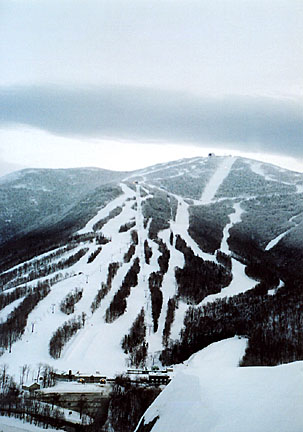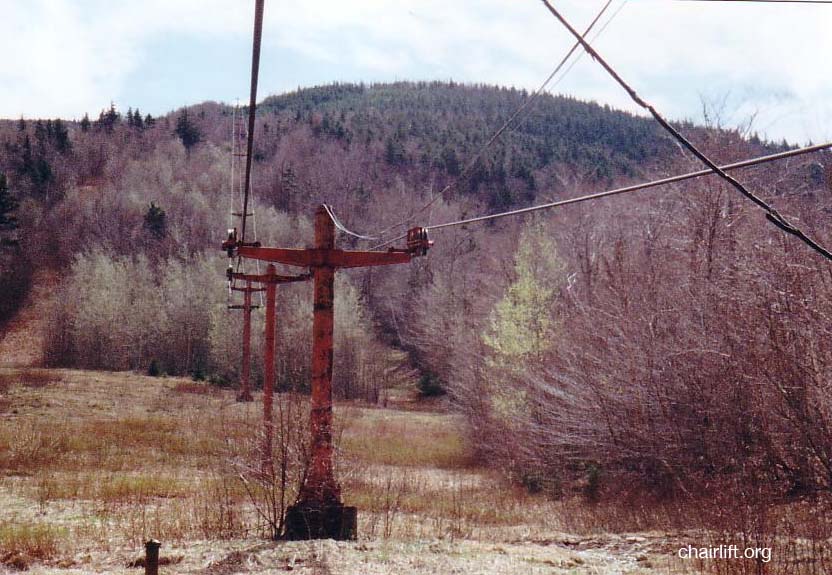
This past weekend, Emily Hoffer, my Mizpah croomate last fall, and I skied Cannon Mountain. Despite its vertical drop, Cannon is smaller than the best-known New England resorts and has a justified reputation for iciness. Most patrons are locals, including, most famously, Bode Miller.
Only two and a half hours from Boston in the early morning, Cannon’s massive eastern cliff face (the northeast’s only true “big wall”) forms the western side of Franconia Notch. While riding the lifts, one can gaze out at the ramparts of Franconia Ridge, rocky and aspiring. On the “front five,” the steep trails visible from Route 93, skiers plunge toward frozen Profile Lake. The only resort in New England with comparable scenery is Wildcat.

Cannon was among the first mountains colonized by early American ski pioneers. They cut the Taft Slalom Trail, the country’s first racing trail, in 1933. In 1938, the resort built an aerial tramway leading to the summit (it was replaced in 1980), which gives the resort a slightly European flavor. Operated by the state, Cannon is devoid of slopeside condos and non-ski related activities.
I first noticed the adjacent Mittersill ski area years ago when, taking the westernmost trail from summit, I passed a side trail leading up Cannon’s exposed northwestern spur. It wasn’t on the regular trail map, and I couldn’t ascend it on my alpine skis, but the trail was clearly trafficked. My curiosity was piqued. Down at the parking lot, I could see another whole network of trails on the north side of the mountain. Clearly, the side trail connected the two.
Now, having acquired AT gear, skins, and a little backcountry experience, Emily (who telemarks) and I spent Saturday night, up at Lonesome again with Bajo, perusing a backcountry ski guide for tips. The next day, after a couple of sunny runs at Cannon, we cut over to the connecting trail, donned our skins, and headed up the spur sometimes called Mt. Mittersill.
So far, so good. At the top of our brief climb, somebody had left a chair, so we took turns taking photos of each other trying to look hard-core and nonchalant with the Franconias in the background. Skinning up the spur is worthwhile even without skiing Mittersill—the view of the Cannon Balls and Kinsmans, is unique and dramatic.
Off went the skins, and we began our descent, trying to stay ahead of some local Yankees, who promptly flew past us. Now things began to get a bit dicey. We had hoped for some remnants of powder; instead we got moguls—not my strength. Apparently, the regulars at Cannon had gotten there ahead of us. The terrain was icy and in places, very narrow and steep. I fell many times, once getting my foot caught in the underbrush and tweaking my shoulder and neck when I hit the ground. It was obvious that we missed the broad trails visible from the parking lot. Our descent became a rout—skis coming off for the worst bits, finally breaking back to the bunny slopes at Cannon. I’m sure Mittersill’s a great destination on a powder day, but I’ll wait for a couple of good fresh feet to go back.
Despite the efforts of locals to cut back summer growth, the forest is encroaching on the trails, which were never that wide

anyway. The old lift towers, still holding up a rusty cable, are an eerie reminder of the resort’s past. Like anything abandoned by humans, the old trail complex has an aura of mystery and loneliness, especially as the afternoon shadows grow longer.
At one point on our tour along the abandoned trails, we looked straight down the liftline to the old base lodge, which is surrounded by outhouses and chalets. The road to it appeared to be open, so after finishing our day over at Cannon, we decided to investigate.
The lodge, to our surprise, was open. An old woman at the reception desk gave us a brief synopsis of Mittersill’s history and its founder, an Austrian émigré, Baron Hubert van Pantz, whose family made a fortune in iron mining. In 1935, he bought Schloss Mittersill, a Tyrolean Castle with fabulous views of the Alps. His renovations transformed it into a base for hunting and skiing, but shortly after the Anschluss, Nazi Germany’s annexation of Austria, the German SS confiscated the castle. Like Captain Von Trapp in The Sound of Music, the Baron resisted conscription and fled to America.
The Baron was drawn to the Franconia area by the tram at Cannon. He bought 550 acres adjacent to the existing resort and,

in 1945, opened the Mittersill resort, then just a small T-bar known as the “alpine lift.” The base hotel, however, was striking. Complete with long overhanging expanses of wood on the upper stories and decorative shields, the lodge’s design was loosely based on the Baron’s Schloss Mittersill in Austria. Indeed, the Baron made a post-World War II visit in 1950 to examine his property, where despite damage from research by a Nazi doctor trying to justify Nazi ideology of racial superiority, he restored his club. Today, Schloss Mittersill is a Christian study center.
Though small, the American Mittersill was glamorous. The Baron and his wife’s guests included a Dutch Prince, a Princess from Liechtenstein, and the Duke and Duchess of Windsor. Bob Hope was another visitor, but he preferred golf to skiing.
In 1969, the resort gained a double chair and expanded to nine trails, increasing vertical elevation to 1400 feet. The trails were surprisingly challenging for such a small resort. Mittersill’s heyday was short-lived, however, for by 1978, the ski area had closed. Mittersill could not compete with Cannon Mountain, itself small compared to the best-known resorts in New England.
The lodge now serves as a center for the surrounding condos and time-shares, which, to judge by the tracks coming across from Cannon, are popular with skiers on that mountain.
The state has plans for expanding Cannon, however. It has proposed a land swap with the National Forest to acquire the top of Mittersill, which needs to connect the two resorts. In exchange, it will give up the Second Presidential State Forest, which abuts the southern end of Franconia State Park in Lincoln. Then, using proceeds from the lease of Mt. Sunapee, it will revamp the Mittersill slopes and merge the two resorts.
From a conservationist’s point of view, or indeed that of an enthusiastic backcountry skier, it is hard to condone Cannon’s expansion. Nevertheless, with the efforts of Baron Van Pantz in mind, I find myself fighting back enthusiasm for the state’s project. Whether or not it goes through, I am glad to have experienced abandoned Mittersill as it exists now, icy moguls and all.

 Last December, President Bush quietly signed into law the New England Wilderness Act, which augments several existing wilderness areas and creates three entirely new ones—74,000 new acres of wilderness in all. Hikers and other wilderness enthusiasts in the northeast should thank their lucky stars. The bill is an aberration, a consequence of rare support from Congressional Republicans, whose championing of environmental issues has been virtually unheard of for the past six years.
Last December, President Bush quietly signed into law the New England Wilderness Act, which augments several existing wilderness areas and creates three entirely new ones—74,000 new acres of wilderness in all. Hikers and other wilderness enthusiasts in the northeast should thank their lucky stars. The bill is an aberration, a consequence of rare support from Congressional Republicans, whose championing of environmental issues has been virtually unheard of for the past six years.  These New Hampshire Republicans, though fiscally conservative, take a moderate approach to environmental issues. Gregg and Bradley, in particular, have a real affinity for the outdoors—Bradley is a member of the Appalachian Mountain Club’s New Hampshire 4000 Footer Club, and all members are strongly supported by hunting and fishing groups. Their stance was good politics, as well. With the electorate clearly leaning Democratic last fall, the New England Wilderness Act offered a chance for distinction from President Bush.
These New Hampshire Republicans, though fiscally conservative, take a moderate approach to environmental issues. Gregg and Bradley, in particular, have a real affinity for the outdoors—Bradley is a member of the Appalachian Mountain Club’s New Hampshire 4000 Footer Club, and all members are strongly supported by hunting and fishing groups. Their stance was good politics, as well. With the electorate clearly leaning Democratic last fall, the New England Wilderness Act offered a chance for distinction from President Bush.  not taken as proof of the natural world’s health or an excuse for development. Rather, they are a repository of tranquility where we can acknowledge humanity’s complicated relationship with nature and, I hope, resolve to do better.
not taken as proof of the natural world’s health or an excuse for development. Rather, they are a repository of tranquility where we can acknowledge humanity’s complicated relationship with nature and, I hope, resolve to do better.
 This past weekend, Emily Hoffer, my Mizpah croomate last fall, and I skied Cannon Mountain. Despite its vertical drop, Cannon is smaller than the best-known New England resorts and has a justified reputation for iciness. Most patrons are locals, including, most famously, Bode Miller.
This past weekend, Emily Hoffer, my Mizpah croomate last fall, and I skied Cannon Mountain. Despite its vertical drop, Cannon is smaller than the best-known New England resorts and has a justified reputation for iciness. Most patrons are locals, including, most famously, Bode Miller.  Cannon was among the first mountains colonized by early American ski pioneers. They cut the Taft Slalom Trail, the country’s first racing trail, in 1933. In 1938, the resort built an aerial tramway leading to the summit (it was replaced in 1980), which gives the resort a slightly European flavor. Operated by the state, Cannon is devoid of slopeside condos and non-ski related activities.
Cannon was among the first mountains colonized by early American ski pioneers. They cut the Taft Slalom Trail, the country’s first racing trail, in 1933. In 1938, the resort built an aerial tramway leading to the summit (it was replaced in 1980), which gives the resort a slightly European flavor. Operated by the state, Cannon is devoid of slopeside condos and non-ski related activities.  anyway. The old lift towers, still holding up a rusty cable, are an eerie reminder of the resort’s past. Like anything abandoned by humans, the old trail complex has an aura of mystery and loneliness, especially as the afternoon shadows grow longer.
anyway. The old lift towers, still holding up a rusty cable, are an eerie reminder of the resort’s past. Like anything abandoned by humans, the old trail complex has an aura of mystery and loneliness, especially as the afternoon shadows grow longer. in 1945, opened the Mittersill resort, then just a small T-bar known as the “alpine lift.” The base hotel, however, was striking. Complete with long overhanging expanses of wood on the upper stories and decorative shields, the lodge’s design was loosely based on the Baron’s Schloss Mittersill in Austria. Indeed, the Baron made a post-World War II visit in 1950 to examine his property, where despite damage from research by a Nazi doctor trying to justify Nazi ideology of racial superiority, he restored his club. Today, Schloss Mittersill is a Christian study center.
in 1945, opened the Mittersill resort, then just a small T-bar known as the “alpine lift.” The base hotel, however, was striking. Complete with long overhanging expanses of wood on the upper stories and decorative shields, the lodge’s design was loosely based on the Baron’s Schloss Mittersill in Austria. Indeed, the Baron made a post-World War II visit in 1950 to examine his property, where despite damage from research by a Nazi doctor trying to justify Nazi ideology of racial superiority, he restored his club. Today, Schloss Mittersill is a Christian study center.